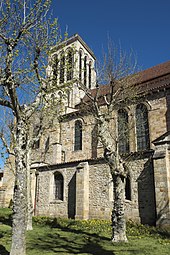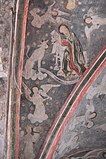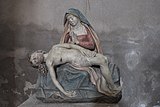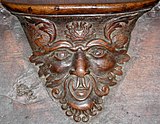St-Cerneuf (Billom)
The Catholic parish church of Saint-Cerneuf in Billom , a commune in the Puy-de-Dôme in the French region of Auvergne Rhône-Alpes , is a Romanesque collegiate back to the 11th or 12th century. It is dedicated to Saint Serenus of Sirmium , a Greek Christian who suffered martyrdom in Sirmium , in the Roman province of Pannonia . Medieval wall paintings have been preserved in the church and in the crypt . The church also has valuable furnishings such as a burial group from the 16th century. In 1923 the church was added to the list of architectural monuments in France as Monument historique .
history
The oldest parts of the church are the crypt , the ambulatory and the lower part of the choir . The nave and the west portal, a pointed portal framed by arched archivolts, were built in the first half of the 13th century on the foundations of the Romanesque predecessor building. In the 13th century the choir was raised and in the 14th century the Chapelle du Rosaire (Rosary Chapel) was added. The Chapelle du Précieux-Sang (Chapel of the Precious Blood) was built in the 17th or 18th century . Until the French Revolution , the church was surrounded by monastery buildings. As a result of the revolution, the canons' monastery was dissolved in 1790 and part of the monastery building was demolished. The commercial court was set up in the former chapter house in 1853/54 . In the years 1863 to 1868, under the direction of the architect Aymon Gilbert Mallay, major renovations and restoration work took place in the church. A new bell tower was built on the west facade.
architecture
inner space
The interior, a three-aisled hall , is divided into four bays . The ribbed vaults rest on very high pillars with pillars. The bases of the columns are decorated with corner leaves. In the choir, the eight columns that support the stilted round arches have been preserved from the Romanesque church building. The groin vault and the 14 capitals of the inserted columns in the ambulatory have also been preserved, some of which may date from the 11th century and were probably reused. They are decorated with acanthus and palm leaves , some with figural scenes. The eight-pointed cross-ribbed vault of the Gothic-style choir runs towards a keystone carved with oak leaves and rests on consoles on which the heads of men and women with typical headgear from the second half of the 13th century are depicted.
crypt
The crypt was probably built at the end of the 11th century with the inclusion of an older predecessor. It consists of three small naves and an ambulatory that opens onto four chapels with a horseshoe-shaped floor plan. The main room and ambulatory are covered by groin vaults, which are supported in the main room by four square pillars and four alternating columns and in the choir by massive round supports.
Rosary Chapel
At the beginning of the 14th century, Gilles I. Aycelin de Montaigut , who came from the castle in Glaine-Montaigut near Billom , had the rosary chapel built as a burial chapel for himself and his family. Originally the chapel was an independent building, from which a portal on the west side led into the cloister . It was walled up when the sacristy was added at the end of the 18th century . The chapel consists of a yoke and an apse with a quintuple closure , which are covered with ribbed vaults.
Murals
Wall paintings in the crypt
The tempera wall paintings in the crypt are dated to the late 12th century. They depict episodes from the legend of St. Margaret of Antioch , how she escapes alive from the belly of a dragon and her beheading with the sword. The little scene with a woman lying in bed is an indication of the veneration that women giving birth showed to the saint.
Wall paintings on the west wall
Fragments of wall paintings from the 14th century have been preserved on the west wall of the nave. On the arch soffit angels are with the suffering tools shown on the wall the Annunciation and episodes from the life of St. Avitus.
Wall paintings in the Rosary Chapel
The wall and vault paintings in the Rosary Chapel were discovered in the late 1960s and exposed again between 1971 and 1976. They were executed around 1314 using fresco technique and tempera painting.
In the east, on the north and south walls, the allegorical figures of the Ecclesia and the synagogue , the defeated synagogue and the triumphant church face each other. The figure of the synagogue is blindfolded, its lance is broken. The figure of the Church wears a crown on her head, she holds the cross in her right hand and the chalice with the blood of Christ in her left. Three lion heads, the coat of arms of the Aycelin family , can be seen above the representation of the synagogue . The profile representation in a medallion on the same side is interpreted as a portrait of Gilles Aycelin de Montaigut.
In the west, on the south wall, surrounded by a six-pass held by two angels, the Assumption of Mary is depicted. Below are the apostles looking up at the scene. In the foreground, the unbelieving Thomas kneels , who receives a belt from Maria as proof of what happened. The picture below shows St. Christopher carrying the baby Jesus on his shoulders. On the north wall the ascension of Jesus is depicted, who disappears behind a cloud and of which only the feet can be seen, below are the disciples looking upwards. On the west wall you can see the coronation of Mary by Jesus Christ, above in a medallion God the Father . Angels making music hover over the scene.
The vaulted fields are decorated with numerous angels making music and angels holding labels. They frame the four evangelists , Matthew , Mark , Luke and John , who are represented with their symbols and a pen in their hand.
Leaded glass window
The stained glass windows of the church date from the 19th century. The oldest windows were made in the workshop of Étienne Thevenot in Clermont-Ferrand in 1840. They depict Saint Anne and Saint Joachim , Saint Joseph and the Apostle Peter and Saint Dominic receiving the rosary from Our Lady . Two windows from 1844 depict the apostles Peter and Paul . The upper windows were also made by Étienne Thevenot in 1848. They depict Mary and Jesus and the twelve apostles as well as saints who are particularly venerated in the region, such as the Jesuit Jean François Régis and the patron saint of the church, Saint Serenus.
The windows of the Axial Chapel, the Chapel of the Precious Blood, were made in the workshop of Charles des Granges in Clermont-Ferrand in 1873. They take up scenes from the Passion of Jesus like Jesus and the disciples on the Mount of Olives, the handkerchief of Veronica and Jesus carries the cross and meets his mother. A Pietà is depicted on one window , two windows refer to the veneration of the hearts of Jesus and Mary .
Entombment group
The burial group originally stood in the Holy Sepulcher Chapel (Chapelle du Saint-Sépulcre), which was attached to the south aisle and which was demolished in the 19th century. The group of sculptures was created by a wandering workshop in the first half of the 16th century. Eight life-size people are grouped around the body of Jesus. At the head of Jesus stands Joseph of Arimathea , opposite him, at the feet of Jesus, is Nicodemus . Behind the grave you can see five women and the apostle John . Johannes forms a group of three with Maria and another woman. The other three women, including Mary Magdalene (far left) with an ointment vessel in hand, and St. Veronica (in the middle), stand in isolation. Joseph of Arimathea is dressed in a precious robe. He wears a pointed Jewish hat common in the Middle Ages . To the side of the grave are two smaller angel figures, both of which are holding a vessel, perhaps an hourglass. It has not been established whether they originally belonged to the burial group.
Further equipment
- The figure of the Archangel Michael, who stands nearby and rescues a soul, depicted as a naked child, from the clutches of a dragon probably also comes from the master of the burial group.
- The group of sculptures known as Notre-Dame-du-Canada is actually a representation of the teaching of Mary. It is made of stone and probably dates from the 16th century. It was damaged during the French Revolution and the head of Mary was replaced by the carved head of a baby Jesus.
- The colored pietà made of limestone is also a work of the 16th century.
- The two holy water stoups made of lava stone on the west and north sides date from the 17th century. The bowl on the northern portal rests on a Gothic capital carved with heads.
- The choir stalls , carved from oak, date to the late 17th century. From the original choir stalls 50 choir stalls are still preserved, the misericords of which are decorated with different human and animal grimaces.
- The lectern also dates from the 17th century. It is formed by two upright lions leaning against each other.
Tomb of Gilles I. Aycelin de Montaigut
In the rosary chapel there is a wall niche tomb, which was probably created for Gilles I. Aycelin de Montaigut , Archbishop of Narbonne and later of Rouen , after his death in 1318. It consists of Volvic stone and is covered with a layer of plaster painted gray. A triangular gable decorated with pinnacles above a cloverleaf arch frames the large central niche, the wall side of which is provided with a relief of the Nativity. In the middle of the gable, surrounded by a quadrilateral arch, there is a relief of a Majestas Domini . In the smaller side niches below the apostles Peter with key and Paul with sword can be seen. The Archangel Gabriel and the Virgin Mary of the Annunciation scene are depicted in the two upper niches . The figures in the middle niches are missing, as is the reclining figure of the deceased made of white marble, which was destroyed during the French Revolution . The eight figures on the base, which stand under arcades with three-pass arches , are supposed to represent relatives of the deceased who exercised important ecclesiastical offices such as his brothers, Cardinal Hugues Aycelin and Jean, Bishop of Clermont , his sister, an abbess, another brother, an uncle and a great-uncle who were Canons of Saint-Cerneuf.
literature
- Michel Andan: La collégiale Saint-Cerneuf de Billom . Parish of Saint-Martin des Marches du Livradois (ed.), Pastorale Tourisme & Loisir 2017.
- Bernard Craplet: Auvergne novels . 2nd edition, Éditions Zodiaque, Abbaye de la Pierre-Qui-Vire 1958, p. 27.
Web links
- Église Saint-Cerneuf in the Base Mérimée of the French Ministry of Culture (French)
- Collégiale de chanoines Saint-Cerneuf in the Base Mérimée of the French Ministry of Culture (French)
Individual evidence
- ↑ Église Saint-Cerneuf in the Base Mérimée of the French Ministry of Culture (French)
- ↑ Peinture murale: légende de sainte Marguerite in the Base Palissy of the French Ministry of Culture (French)
- ↑ Peintures monumentales de la chapelle ouest in the Base Palissy of the French Ministry of Culture (French)
- ↑ Peinture murale: Annonciation, Légende de saint Avit d'Orléans in the Base Palissy of the French Ministry of Culture (French)
- ↑ Peintures monumentales de la chapelle du Rosaire in the Base Palissy of the French Ministry of Culture (French)
- ↑ Peinture monumentale des murs de la chapelle du Rosaire in the Base Palissy of the French Ministry of Culture (French)
- ↑ Peinture monumentale des voûtes de la chapelle du Rosaire in the Base Palissy of the French Ministry of Culture (French)
- ↑ Mise au tombeau in the Base Palissy of the French Ministry of Culture (French)
- ↑ Mise au tombeau in the Base Palissy of the French Ministry of Culture (French)
- ↑ Statue: ange tenant dans ses bras une âme menacée par un monstre in the Base Palissy of the French Ministry of Culture (French)
- ↑ Notre-Dame du Canada in the Base Palissy of the French Ministry of Culture (French)
- ↑ Vierge de Pitié in the Base Palissy of the French Ministry of Culture (French)
- ^ Monument funéraire de Gilles Aycelin de Montaigut in the Base Palissy of the French Ministry of Culture (French)
- ↑ Enfeu du tombeau de Gilles Aycelin de Montaigut Listenois in the base Palissy of the French Ministry of Culture (French)
Coordinates: 45 ° 43 ′ 20.6 " N , 3 ° 20 ′ 13.9" E
























